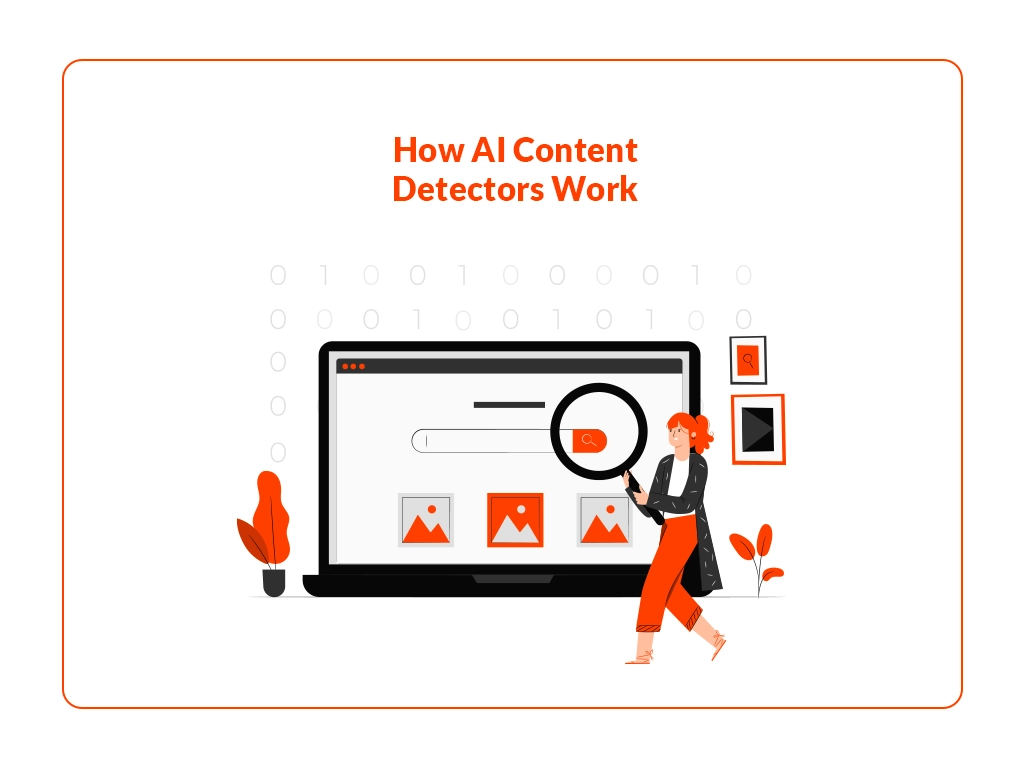How AI Content Detectors Work?
Learn how AI content detectors work to identify AI-generated text, ensure authenticity, and differentiate between human and machine-written content.

Have you ever written a blog completely on your own, only to have it flagged by AI content detectors? This is a growing challenge, mostly for content creators. So, how can you avoid this problem? The first step is to know how AI content detectors work!
As AI-generated content becomes more popular with tools like ChatGPT, Jasper, and other AI writing tools, the requirement for AI content detectors is growing rapidly. These detectors are important for marketing professionals, editors, tech experts, content creators, and compliance officers to make sure that the content they handle is genuinely human-written and original. Let’s explore how these tools operate and why they are so crucial in detecting machine-generated text.
What is an AI Content Detector?
An AI content detector is a tool that analyzes all sorts of written text to recognize if it is human-written or AI-generated. These tools have become more proficient in recognizing machine-generated and humanly written content. However, AI content detectors use the latest technologies like machine learning and natural language processing to rectify unique aspects of AI-written content.
These detectors are used by professionals across different industries from content creators to educators to make sure the content is of good quality, organic, and original.
How Do AI Content Detectors Work?
AI content detectors work by analyzing several aspects of the text with models trained on huge datasets of AI-generated and humanly written content. Moreover, they analyze several aspects of the writing such as sentence formation, vocabulary, grammar, and even the flow of ideas. Let’s take a more detailed look at a few of the techniques used here:
1. Natural Language Processing (NLP)
One of the key technologies behind AI content detectors is (NLP), which permits machines to analyze, produce, and interpret human language. In the case of AI content detection, NLP permits tools to break down the formation of text and predict patterns that are more prevalent in machine-generated content.
For example, AI-generated content mostly lacks certain characteristics, creativity, and tone in human writing. NLP algorithms can determine these differences and review whether the content is humanly written.
2. Statistical Analysis
AI content detectors depend on statistics to predict patterns by detecting the frequency of words, sentence formation, and phrases in each sentence. AI-generated content can be repetitive and predictable, whereas humanly written content is mostly varied and diverse.
Statistical models can detect these repetitive patterns and give a probability score indicating if the content is machine generated and if AI uses certain paraphrases and words more often than human writers.
3. Content Authenticity Tools
Content authenticity tools are used to detect the uniqueness and authenticity of written material. These tools are way ahead of traditional plagiarism detection by analyzing if the content is machine-generated. AI-written text, while technically original can sometimes seem conventional and lacks the creativity and depth of humanly written content. Authenticity tools emphasize ensuring that content is according to quality standards and does not depend too much on AI.
AI Writing vs. Human Writing
Recognizing the differences between AI writing and human writing is important for determining machine-generated content and while AI has become more proficient at imitating human language also some major differences that make human writing different from AI writing.
1. Creativity and Nuance
Human writers bring creativity, subtility in writing, and depth of emotion to their work. They mostly write by keeping the targeted audience in mind and customizing their tone and style to pique readers’ interest. Moreover, AI-generated content may sound logically and grammatically appropriate and can feel most of the time repetitive. It mostly lacks the distinctive voice and personality that a human writer offers.
2. Flexibility
Human writing is more feasible to write. Writers mostly experiment with sentence formation, change the words they use, and add personal anecdotes into their work. AI tools that are being trained on large datasets that can duplicate phrases and familiar sentence structures and AI-written content can mostly often seem too refined and consistent which might look like it is not humanly written.
Plagiarism Detection with AI
Additionally, many AI content moderation tools also contain plagiarism detection features. Traditional plagiarism detection tools can detect duplicate content by comparing the text to several databases of prior published material. Moreover, AI-generated content is increasing day by day and there is a requirement for more advanced tools that can detect authenticity beyond simple duplication checks.
AI-based plagiarism detection tools not only detect duplicate content but also analyze if the text was generated by a machine which is mostly necessary for compliance officers and educators who check the authenticity of brand content or academic work.
How to Detect AI in Content
Detecting AI in content can be challenging mostly when AI tools become more advanced and several strategies can assist professionals in detecting machine-generated text:
1. Use AI Content Detectors
The most efficient way to detect AI-generated content is by using a specialized AI content detector. These tools are created to analyze text and flag sections that might have been written by an AI and such tools also offer a probability score which gives users a notion of how the content was machine-generated.
2. Look for Repetitive Language
AI-generated content mostly includes repetitive phrases or awkward sentence formations. While human writers often change the language they use and AI models like GPT use predictable patterns mostly when generating long text.
3. Evaluate Tone and Style
AI-generated content might have a formal or robotic in its tone. In contrast to human writing which can change the tone based on the subject matter, AI usually contains a formal consistent style which makes it simpler to identify.
The Role of AI Content Moderation Tools
As more businesses and many users depend on AI tools for writing, the role of AI content moderation tools has become very crucial. These tools not only detect AI-generated text but also make sure that content is humanly written and has originality in it. This is significantly valuable for digital marketers, content creators, and educators who need to maintain trust and credibility with their users.
Add Why Content Detectors became mainstream in education & research (highlight instances where ethics were challenged) and a separate section on How to Bypass AI Content.
Why Content Detectors became Mainstream in Education & Research?
AI content detectors have become important in research and education due to ethical issues related to academic integrity. With the growth of AI-generated text, researchers and students can simply submit machine-written work as their own which questions about originality. Cases of universities detecting AI-generated essays have generated discussions regarding the role of AI in learning. AI tools have been misused to create papers with incorrect citations or plagiarism which moreover challenges credibility and institutions have also started using AI content detectors to ensure to maintain of academic norms and authentic engagement.
How to Bypass AI Content Detectors (And Why It’s Not Worth It)
While some users try to bypass AI content detectors, it’s essential to know that doing so may have adverse long-term implications. Moreover, here are some standard ways individuals try to avoid detection:
Paraphrasing AI-generated content:
Users may take AI-generated text and paraphrase or rephrase it to make it more human-written. Moreover, this can result in familiar wording and loss of context.
Using hybrid writing:
Some individuals mix AI-generated sentences with their writing to get rid of detectors. This can be still detected by more advanced detection tools that analyze the flow and consistency of the text.
A Smarter Approach: Humanizing AI Content
Instead of relying on superficial editing techniques, content creators and marketers are increasingly turning to advanced solutions that humanize AI text. These tools are specifically designed to improve sentence fluidity, maintain contextual integrity, and infuse natural human tone, enhancing both reader engagement and the ability to pass AI detection systems without compromising authenticity.
Synonym substitution tools:
Some tools replace words with synonyms to make their text look unique and this method often works well as the overall structure remains AI-like and content mostly loses its natural flow.
Conclusion
AI content detectors are becoming necessary as over 55% of the content on search engines is AI-generated which leads to repetitive, robotic text. While search engines have not made it relevant to how they rank or castigate AI-driven content, using convenient AI detection tools is important to maintaining authenticity and quality. For tech professionals, market professionals, educators, and content creators utilizing these tools ensures that your content is unique and original adapting to the evolving digital standards. As things change, focusing on human-written content is the key to success.



